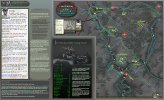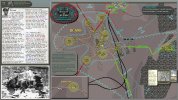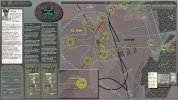You are using an out of date browser. It may not display this or other websites correctly.
You should upgrade or use an alternative browser.
You should upgrade or use an alternative browser.
Return to St Vith Tutorial Planning Aids *Spoiler alert for those playing as Axis*
Dave 'Arjuna' O'Connor
Panther Games Designer
- Joined
- Jul 31, 2014
- Messages
- 3,416
- Points
- 113
- Location
- Canberra, Australia
- Website
- www.panthergames.com
Brilliant Daz. Much appreciated.
David Mangs
Member
This is by far the BEST AAR I've seen for a game. Your examples and explanations are crystal clear...you deserve a hearty Thank You from the entire community...
Regards,
d
Regards,
d
Quick remark: For the 77 FA Bn (155) it says that the 155 mm "Long Tom" had no AT capabilities. That is not correct. The 155 mm field gun could be used with 5 different rounds, and with the Mk I and M7 dummy rounds for training/ceremonial purposes:I have finished page 29 at last and hope to continue at a slow steady speed for a while.
View attachment 3103
- APBC/HE - (AP M112 shell)
- HE - (HE M101 shell)
- Smoke - WP M104 (White Phosphorous)
- Smoke - FS M104 (Sulfur trioxide/chlorosulfonic acid)
- Chemical - H M104 (Mustard gas)
The APBC/HE's amor piercing component pierced through the armor, while the HE component was triggered with a delay, so that it would detonate inside the tank, for maximum effect on crew and ammunition/tank components.
That round could pierce through 135 mm of face hardened armor and through 160 mm of homogenous armor at 457 meters, and still pierce through 152 mm (homog.) and 130 mm (face hardened) armor at 914 meters (all: 30 degrees "meet angle").
The questions here would be whether the APBC/HE shells were meant for area bombardments (say on spotted tank formations) or for direct fire/self defense missions. I am pretty sure that it was for direct fire, as - with the APBC/HE - the gun still delivered a muzzle velocity (the slowest of those 5 types of shells, due to the higher weight) of 837 meters/second.
For comparison: The captured Russian 76.2 mm high-velocity AT gun (1936), slightly modified (so that it could fire German shells - consisting of the cases for the Pak 40 and AP tips designed for the 76.2 mm barrel - which were produced for the gun exclusively) and then used by the Germans under the designation "7,62-cm Feldkanone 296 (r)", delivered muzzle velocities of 740 meters/sec. (AP) and 990 m/sec (with tungsten rounds).
So, the 155 mm Gun M1 delivered more than enough velocity for direct fire, even though it probably lacked advanced iron sights for (easy) direct targeting.
Considering the weight of the AP shells (~ 45 kg), there might have been somewhat curved trajectories with corresponding angles when meeting the target in direct fire on longer distances.
In practice, the APBC/HE fired with the towed TD Bns' 3-inch M5 AT guns turned out to be problematic, as the design of the fuzes had various shortcomings. More than often, the HE components would detonate on impact, so that the AP components could not even penetrate. On other occasions, the HE part would detonate shortly after impact, avoiding full penetration. Even though a redesign of the fuzes or removal of the HE components could have solved the problem, these issues were never addressed. So it's more than likely, that the 155 mm M1's APBC/HE shells had the same problem, as Ian Hogg - in his book "Tank Killing" - describes that the M10 Tank Destroyers (dubbed "Wolverine" by the Brits) had the very same problem with APBC/HE.
Its HE shells could bust through 2.01 meters of concrete (bunkers) at 914 meters ("0 degrees").
Last edited:
Thanks Dave and David 
Very informative information as always, thanks GoodGuy.
I don't know the reason but in this Estab the 155mm Long Tom has no AT capability.
I imagine it has more to do with the difficulty in loading, aiming, traversing and concealing the gun, than its ability to penetrate.
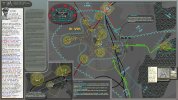
Very informative information as always, thanks GoodGuy.
I don't know the reason but in this Estab the 155mm Long Tom has no AT capability.
I imagine it has more to do with the difficulty in loading, aiming, traversing and concealing the gun, than its ability to penetrate.

Last edited:
The units in St Vith are not exactly in the positions I wanted them in, but are close enough.
There is a bug in the code at the moment that makes it very difficult to move short distances with your units.
As a work around I have been ordering the units to move via the shortest route, and placing the destination at least a kilometer away from the unit, passing through the location I want them in.
When it gets close to the location I want them to occupy, I then delete the order, or reattach them to the HQ. They stop a short distance later, after a short command delay.
Another method is to give them a Fire order. They will then stop moving after a brief exchange of fire at an arbitrary location. This method wastes ammunition so I don't use it.
Hopefully Dave will fix this annoying bug again soon.
There is a bug in the code at the moment that makes it very difficult to move short distances with your units.
As a work around I have been ordering the units to move via the shortest route, and placing the destination at least a kilometer away from the unit, passing through the location I want them in.
When it gets close to the location I want them to occupy, I then delete the order, or reattach them to the HQ. They stop a short distance later, after a short command delay.
Another method is to give them a Fire order. They will then stop moving after a brief exchange of fire at an arbitrary location. This method wastes ammunition so I don't use it.
Hopefully Dave will fix this annoying bug again soon.
Very informative information as always, thanks GoodGuy.
I don't know the reason but in this Estab the 155mm Long Tom has no AT capability.
I imagine it has more to do with the difficulty in loading, aiming, traversing and concealing the gun, than its ability to penetrate.
Especially with lowered barrel (for direct fire), a camo net offered some level of concealment, in open terrain, at least. Woods and trees could also be used, to some extent. Such gun did not have the size of a Thor or Karl mortar:
Second Army maneuvers in Tennessee (1942):
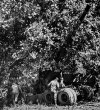
US Artillery training in England:
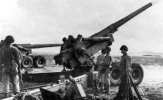
German Arty Bns had - in addition to an AA detachment - security detachments, which also set up early warning obs. posts, to be able to give advance warnings (raids, enemy assaults on arty positions).
M12 gun carriage units had carbine observer teams, so I am guessing that a towed US FA unit employed similar teams.
The same gun (on a M12 gun carriage) in action (direct fire):
As you see, even though the propellant charge had to be inserted as separate "powder bag" (the gun was classed as "secondary coastal gun" by US ordnance), the loading process could be completed in a relatively short time (since the barrel did not have to be lowered and elevated again) for direct fire.
In the video, it takes the crew around 20 seconds to reload the gun.
Loading was not an issue. Since German tanks usually stopped to aim/fire, FA gun crews had at least a chance to track (means traverse/follow) a german tank and fire at it, especially if they fired from concealed positions.
Last edited:
Dave 'Arjuna' O'Connor
Panther Games Designer
- Joined
- Jul 31, 2014
- Messages
- 3,416
- Points
- 113
- Location
- Canberra, Australia
- Website
- www.panthergames.com
The real issue though is not whether these units had the capability but whether operationally they used it. AFAIK they rarely used it and for good reasons. First, an it's a biggy, their prime role was not AT. Second, they were extremely vulnerable to direct or indirect fire once targeted. While the tracked versions (which were not that prolific) could withdraw relatively quickly, the towed version took a long time to mount up and move. In that time the crew are fully exposed. IMO it would be a desperate or foolish commander that would use these guns in that role.
GoodGuy, Thanks for the details and pics. Your knowledge and expertise is great.
GoodGuy, Thanks for the details and pics. Your knowledge and expertise is great.
I have compiled the pdf for the first part, that's pages 1 to 30.
I did a lot of reading up on the best options for reduced size, primarily for online viewing, but with good quality printing to a home printer.
Its 72 MB in size.
Where do I send it and what method should I use for a file of that size?
Edit: Its ok I worked it out myself
I have uploaded it to the Resources section Url is here:
http://forums.lnlpublishing.com/res...to-st-vith-tutorial-aar-part-1-pages-1-30.85/
I did a lot of reading up on the best options for reduced size, primarily for online viewing, but with good quality printing to a home printer.
Its 72 MB in size.
Where do I send it and what method should I use for a file of that size?
Edit: Its ok I worked it out myself
I have uploaded it to the Resources section Url is here:
http://forums.lnlpublishing.com/res...to-st-vith-tutorial-aar-part-1-pages-1-30.85/
Last edited:
The ammunition was available in the theater. During the Battle of the Bulge, several HQs, smaller depots, and arty positions were overrun by the Germans. If there was ordnance with AT capabilities, attempts to put them to good use for self defense were made, most likely.The real issue though is not whether these units had the capability but whether operationally they used it. AFAIK they rarely used it and for good reasons.
Of course, they were field artillery pieces, and not dual (or even triple) purpose guns (like say the German Flak 88's with their AA, artillery and AT roles).First, an it's a biggy, their prime role was not AT.
Correct, they didn't even have shields for crew protection, so it would have been suicidal to employ these in a dedicated AT role.Second, they were extremely vulnerable to direct or indirect fire once targeted.
With the tracked version, the M12 gun carriage, the thickest armor section (glacis?) featured 50 mm of armor, only, while other sections had only 12.7 mm of armor, barely enough to protect against regular rifle rounds. There was a chance that standard rifle AP rounds (used by the Germans) could pierce through some of those weak sections.
Its profile (with lowered gun) wasn't as tall as say the profile of a Sherman tank, though:
M12 in France:
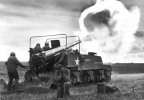
While the tracked versions (which were not that prolific)...
Actually, they were very successful during the assault on the Siegfried Line: The M12 gun motor carriages were brought foward to crack the Line's bunkers with direct fire, and were then dubbed "doorknockers" by US units. Since they could pierce through 2 meters of concrete, "bunker busters" would probably be the better term.
... could withdraw relatively quickly, the towed version took a long time to mount up and move. In that time the crew are fully exposed. IMO it would be a desperate or foolish commander that would use these guns in that role.
I am not talking about employing them as dedicated (dual purpose) AT guns, but about instances where (deployed) 155 mm-guns are threatened to be attacked or overrun. Call it "desperate" or "ballsy", but a commander in charge of such guns would have ordered to fire at incoming Germans. During the Battle of the Bulge, some units just got into such situation:
"The 333rd FA Group (333rd {155mm}, 969th {155mm} and 771st {4.5-inch} FA Battalions) initially supported the 2nd Infantry Division (United States) and its replacement, the 106th Infantry Division. At the onset of the Battle of the Bulge they were eleven miles behind the front lines. With the rapid advance of the Germans, the 333rd FA Battalion was ordered to withdraw further west, but C and Service Batteries were ordered to stay behind to give covering fire to the 106th Division. On 17 December they were overrun with most killed or captured."
A Wikipedia quote (yeah yeah, i know), but I've read about these details somewhere else before (official Army history?). It looks like most of the pieces were evacuated (IIRC), but the 2 batteries were supposed to do both: Cover the 106th Division (where the bulk surrendered to the Germans on the 19th of December) and form a blocking position (direct fire), which didn't work out, apparently, as they got wiped out or captured.
According to what I've read, some of them put up a fight before they got killed, and since they had several small obs teams, they must have had time to traverse and aim, at least. I doubt that they just used their rifles/hands to fight the incoming Germans.
Last edited:
Dave 'Arjuna' O'Connor
Panther Games Designer
- Joined
- Jul 31, 2014
- Messages
- 3,416
- Points
- 113
- Location
- Canberra, Australia
- Website
- www.panthergames.com
Good to hear. Thanks Daz. You are a champion.I have compiled the pdf for the first part, that's pages 1 to 30.
I did a lot of reading up on the best options for reduced size, primarily for online viewing, but with good quality printing to a home printer.
Its 72 MB in size.
Where do I send it and what method should I use for a file of that size?
Edit: Its ok I worked it out myself
I have uploaded it to the Resources section Url is here:
http://forums.lnlpublishing.com/res...to-st-vith-tutorial-aar-part-1-pages-1-30.85/
In that time the crew are fully exposed. IMO it would be a desperate or foolish commander that would use these guns in that role.
In CO2, in one of the stock scenarios, US units dash down to the South East corner (the German player's starting position/"spawn point"). The Player AI usually parks some of the bases and one or another Artillery unit in that corner. If Arty and Supply bases are detached, the player (not knowing that an attack will come down that Northern road) will be tempted to park arty and base units there as well, as it looks like a very safe area, and because enemy units are pretty near on the road leading to the next town in the West, so that the area actually has to be used to set up supply bases and arty units.
The US AI then dashes down with fast tracked vehicles (and some armor), and also attacks with tanks from the south west performing an attack on supply lines, where then the deployed arty units have no means to defend themselves against these armored units.
Historically, this is not correct.
Even though the fuzes of the APBC/HE appeared to be unreliable, they offered some means (or chances) to combat armored units, at least.
Given the reload time (see video above), even towed guns had at least a chance to fire one or another round before they got destroyed or their crews suppressed by MG fire. If such an arty piece was dug in (depression or dedicated arty nest), camo'ed or protected by sandbag barriers, tanks had to get somewhat closer to clear the positions, which sureley gave deployed arty crews time to fire a few rounds.
I tend to agree , maybe all arty units should be given AT capability , even if its just a few AP rounds per gun , and perhaps a slow R.O.F and poor accuracy .In CO2, in one of the stock scenarios, US units dash down to the South East corner (the German player's starting position/"spawn point"). The Player AI usually parks some of the bases and one or another Artillery unit in that corner. If Arty and Supply bases are detached, the player (not knowing that an attack will come down that Northern road) will be tempted to park arty and base units there as well, as it looks like a very safe area, and because enemy units are pretty near on the road leading to the next town in the West, so that the area actually has to be used to set up supply bases and arty units.
The US AI then dashes down with fast tracked vehicles (and some armor), and also attacks with tanks from the south west performing an attack on supply lines, where then the deployed arty units have no means to defend themselves against these armored units.
Historically, this is not correct.
Even though the fuzes of the APBC/HE appeared to be unreliable, they offered some means (or chances) to combat armored units, at least.
Given the reload time (see video above), even towed guns had at least a chance to fire one or another round before they got destroyed or their crews suppressed by MG fire. If such an arty piece was dug in (depression or dedicated arty nest), camo'ed or protected by sandbag barriers, tanks had to get somewhat closer to clear the positions, which sureley gave deployed arty crews time to fire a few rounds.
Oh yes , without a doubtThis is by far the BEST AAR I've seen for a game. Your examples and explanations are crystal clear...you deserve a hearty Thank You from the entire community...
Regards,
d
Iconoclast
Member
Love your updates Daz. But referring to page 29: I would have loved to see the faces of your HQ personnel from 35th Bn, when they have been told they are to "block" the advance of enemy units  How did they take it?
How did they take it?
He said he was looking forward to the opportunity of being able to fire the main armament of his Sherman again 
With the 2 Sherman's they can actually interdict the road from there, but are screened by the river, a steep slope down to it and the lack of a track between them and the road, making it difficult for an attack coming from that direction.
Infantry can still come through the trees and surprise them of course, but then they could from almost anywhere in the sector, from any direction.
With the 2 Sherman's they can actually interdict the road from there, but are screened by the river, a steep slope down to it and the lack of a track between them and the road, making it difficult for an attack coming from that direction.
Infantry can still come through the trees and surprise them of course, but then they could from almost anywhere in the sector, from any direction.
Last edited:
I have noticed there is a little problem with auto facing getting stuck, with in Situ orders on loading a new game.
Its dead easy to get it working again.
All you have to do is give them a facing quickly (preferably in the direction of the main threat) then switch them straight back to auto facing.
After doing this is seems to free them up and after a command delay, they will face the main threats again on auto facing.
That's why all my units in St Vith are facing south in the images, I hope from now on they will have better facings.
Its dead easy to get it working again.
All you have to do is give them a facing quickly (preferably in the direction of the main threat) then switch them straight back to auto facing.
After doing this is seems to free them up and after a command delay, they will face the main threats again on auto facing.
That's why all my units in St Vith are facing south in the images, I hope from now on they will have better facings.
Similar threads
- Replies
- 82
- Views
- 19K
- Replies
- 2
- Views
- 4K
- Replies
- 0
- Views
- 1K
